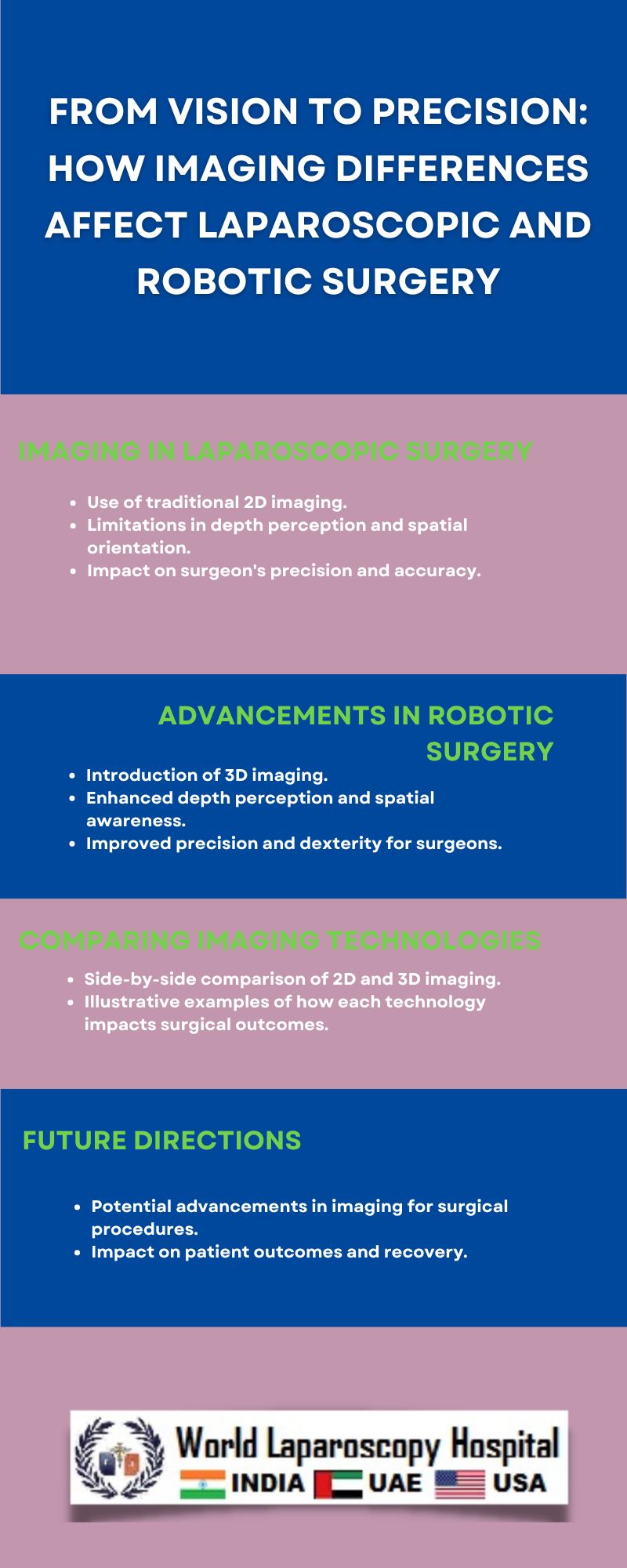From Vision to Precision: How Imaging Differences Affect Laparoscopic and Robotic Surgery
Introduction
In the realm of modern surgical techniques, laparoscopic and robotic surgeries have revolutionized the way complex procedures are performed. Both techniques rely heavily on advanced imaging technologies to provide surgeons with enhanced visualizations and precision. However, the choice between laparoscopic and robotic surgery often depends on various factors, including the nature of the procedure, the surgeon's expertise, and the available resources. Understanding the differences in imaging modalities between these two approaches is crucial for optimizing patient outcomes.

Imaging in Laparoscopic
Surgery Laparoscopic surgery, also known as minimally invasive surgery, involves making small incisions through which a camera and specialized surgical instruments are inserted. The camera, known as a laparoscope, provides a 2D visual representation of the surgical field on a monitor. While this technique has significantly reduced the trauma and recovery time associated with traditional open surgery, it has limitations in terms of depth perception and spatial orientation.
The 2D imaging in laparoscopic surgery can sometimes make it challenging for surgeons to accurately judge the distance between instruments and tissues. This limitation is particularly relevant in procedures that require precise manipulation, such as suturing and dissection. Surgeons often rely on their experience and hand-eye coordination to compensate for this lack of depth perception.
Imaging in Robotic Surgery
Robotic surgery, on the other hand, incorporates advanced imaging technologies and robotic arms controlled by the surgeon from a console. The imaging system in robotic surgery typically provides a 3D high-definition view of the surgical site, enhancing depth perception and spatial awareness. This improved visualization allows for more precise and controlled movements during the procedure.
The robotic arms used in surgery are equipped with specialized instruments that mimic the movements of a surgeon's hands with greater dexterity and range of motion. The surgeon controls these instruments from the console, translating their hand movements into precise actions inside the patient's body. The combination of 3D imaging and robotic assistance enhances the surgeon's ability to perform complex procedures with greater accuracy and efficiency.
Comparing Imaging Modalities
The key difference in imaging modalities between laparoscopic and robotic surgery lies in the depth perception and spatial awareness provided to the surgeon. While laparoscopic surgery offers a 2D view of the surgical field, robotic surgery provides a 3D view, allowing for better visualization of anatomical structures and more accurate instrument manipulation.
The enhanced imaging in robotic surgery can be particularly beneficial in procedures that require intricate maneuvers, such as nerve-sparing techniques in prostate surgery or delicate tissue dissection in gynecological procedures. The improved depth perception and spatial awareness provided by robotic surgery can lead to better outcomes and reduced complications compared to laparoscopic surgery.
Challenges and Considerations
Despite the advantages of robotic surgery in terms of imaging and precision, there are challenges and considerations that need to be addressed. The cost of robotic systems and the associated training for surgeons can be significant barriers to widespread adoption. Additionally, the reliance on technology introduces the potential for technical malfunctions or errors, requiring a well-trained team to manage.
Another consideration is the learning curve associated with robotic surgery, as surgeons need to become proficient in operating the robotic console. This learning curve can vary depending on the surgeon's prior experience with laparoscopic surgery and their ability to adapt to the robotic interface.
Conclusion
In conclusion, the choice between laparoscopic and robotic surgery depends on various factors, including the complexity of the procedure, the surgeon's expertise, and the available resources. The imaging modalities in these two approaches play a crucial role in determining the precision and outcomes of the surgery. While laparoscopic surgery offers a minimally invasive option with 2D imaging, robotic surgery provides enhanced 3D imaging and precision through robotic assistance. Understanding these differences is essential for surgeons and patients in making informed decisions about the most appropriate surgical approach.
Laparoscopic surgery emerges as a stalwart in the surgical arena, offering significant advancements in minimally invasive procedures. Yet, its reliance on 2D imaging poses challenges in depth perception, underscoring the importance of surgeon expertise and adaptability.
Conversely, robotic surgery unveils a new frontier of surgical precision, leveraging 3D imaging to enhance spatial awareness and accuracy. The synergy between robotic assistance and advanced imaging fosters unparalleled precision in complex procedures, promising improved outcomes for patients.
As the article deftly navigates the landscape of imaging modalities, it serves as a guiding beacon for surgeons and healthcare professionals, illuminating the path toward optimized surgical techniques and patient care.
Laparoscopic surgery, characterized by its minimally invasive approach, offers surgeons a 2D visual representation of the surgical field through a laparoscope. While this technique has revolutionized surgical practice, its limitations in depth perception can pose challenges, particularly in intricate procedures requiring precise manipulation.
In contrast, robotic surgery leverages 3D high-definition imaging to enhance depth perception and spatial awareness, empowering surgeons with unparalleled precision and control. The synergy of robotic arms and advanced imaging technologies allows for intricate maneuvers with enhanced dexterity, promising superior outcomes for patients.
| Older Post | Home | Newer Post |



